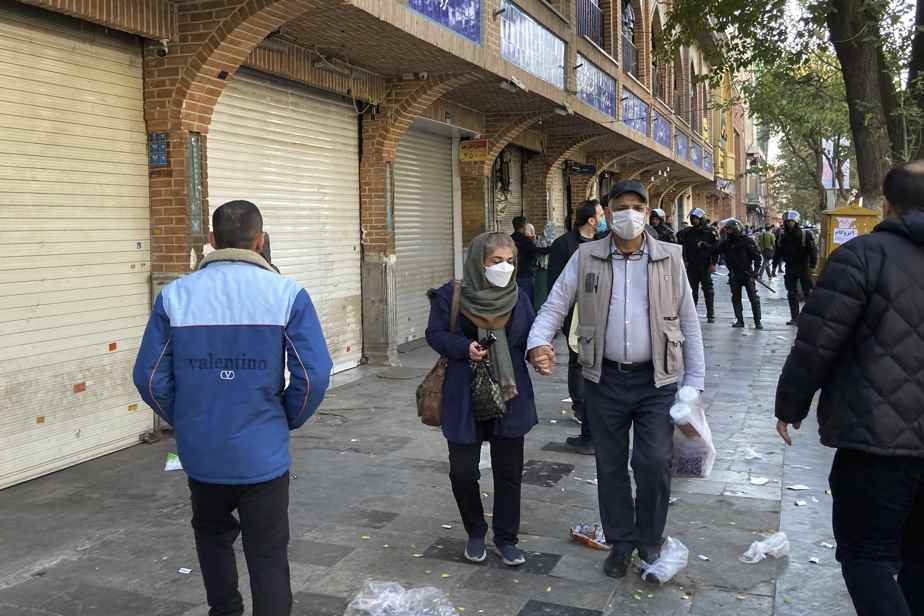(Paris) Iranians took to the streets again on Tuesday after a call by the organizers of protests against the death of Mahsa Amini, to commemorate the deadly crackdown on the unrest sparked in November 2019 by a rise in fuel prices.
A protest movement, also repressed, has shaken the Islamic Republic since the death two months ago of Mahsa Amini, a 22-year-old Iranian Kurd arrested for violating the strict dress code which obliges women to wear the Islamic veil in audience.
Against the background of the din of horns, demonstrators blocked a large roundabout in Tehran, chanting “Freedom, freedom”, according to videos verified by AFP.
As night fell, some gathered around bonfires, chanting “Death to the Dictator”, a slogan targeting Iran’s Supreme Leader Ayatollah Ali Khamenei, according to a video posted by online media 1500tasvir.
People marched in other towns, including Bandar Abbas (south) and Shiraz (south), where women were seen waving their headscarves above their heads.

PHOTO PROVIDED, VIA AGENCE FRANCE-PRESSE
Iranians took to the streets again on Tuesday to commemorate the deadly crackdown on the unrest sparked in November 2019.
In Sanandaj (northwest), protesters burned tires and chanted anti-government slogans, according to another video.
Stores closed
“Woman, life, freedom” and “Man, homeland, prosperity”, shouted students at the Islamic University of Azad in Tabriz (north-west), can we see on another video broadcast by 1500tasvir.
A call for a strike had also been launched in the country.
Shops have closed in the Grand Bazaar of Tehran, as well as in the cities of Kerman (southeast), Mahabad (northwest), Shiraz and Yazd (center), according to videos published by the same source.
Iran’s Mehr news agency reported the majority of shops in the Grand Bazaar were closed, but quoted an employee as saying they closed after protesters “threatened to [les] burn “.
According to the Oslo-based Iranian Kurdish rights NGO Hengaw, work stoppages have been observed in most of the province of Kurdistan (west), where Mahsa Amini was from.
The call for protests on Tuesday came to mark the third anniversary of the start of protests sparked in November 2019 by rising fuel prices, which sparked bloody violence in many cities across the country. Police stations had been attacked, shops looted, banks and petrol stations set on fire.
According to Amnesty International, at least 304 people were killed in the violence. And according to expert testimony reported in late September in a London court, the death toll may even have reached 1,515.
Since the anger sparked by the death of Mahsa Amini on September 16, protests in Iran have multiplied and then transformed into a vast movement against the regime which has ruled the country since the Islamic Revolution of 1979.
“increasing hardness”
At least 326 demonstrators were killed in the crackdown on the movement, according to a report established Saturday by Iran Human Rights (IHR), an NGO based in Oslo.
This figure includes at least 123 people killed since September 30 in the province of Sistan-Baluchistan (southeast), after demonstrations provoked by the alleged rape of a young girl by a police officer.
Protest actions show no sign of abating despite a violent crackdown on largely peaceful protesters, according to human rights NGOs, and a campaign of mass arrests including activists, journalists and lawyers.
Among them is Hossein Ronaghi, defender of freedom of expression on hunger strike, hospitalized on Sunday then returned to prison on Monday evening after his state of health improved.
The Office of the High Commissioner for Human Rights called on Tuesday for the “immediate” release of thousands of people arrested for having taken part in the demonstrations and denounced increasingly severe sentences, such as a recent death sentence for a protesting.
He again denounced the “increasing harshness” of the authorities in the face of the demonstrations.
On Monday, the European Union announced new sanctions targeting 29 Iranian officials, including Interior Minister Ahmad Vahidi, and three institutions, including the public channel Press TV, accused of broadcasting “forced confessions” from detainees after protests over the death of Mahsa Amini were suppressed.
Iran strongly criticized these new sanctions on Tuesday and announced that it reserved the right to respond to them “with force”.
The former Iranian president and main figure of the reformers, Mohammad Khatami, rejected him the idea of a reversal of power in Iran even if, according to him, dominates a dissatisfaction against the current governance.
